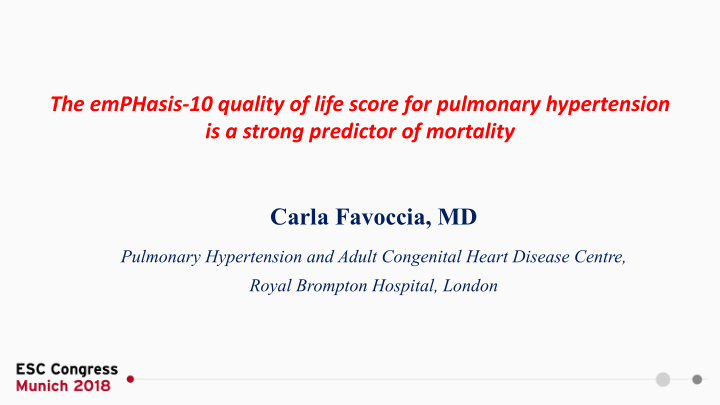



The emPHasis-10 quality of life score for pulmonary hypertension is a strong predictor of mortality Carla Favoccia, MD Pulmonary Hypertension and Adult Congenital Heart Disease Centre, Royal Brompton Hospital, London
Background The presence of PH is debilitating and the symptoms negatively affect the patients’ QOL in terms of physical ability, psychological well-being and social relationships . http://www.phauk.org/
• The emPHasis-10 score is: ü Short and simple questionnaire AIM: ü Does not require complex analysis and to assess the relationship between E10 interpretation. score and mortality in a large cohort of ü Has been designed specifically for use in patients with pulmonary arterial routine clinical practice. hypertension or chronic ü Little is known on E10 relation to thromboembolic PH. outcome.
Results A retrospective study was performed. A total of 2487 E10 were administered to 687 patients over 4 years. 34.8% male, age 51.7±18.4 years. The majority of patients had PAH (80.9%), while 19.1% patients had CTEPH. Average E10 score was 25.3±12.7. There was no significant relationship between age (R-squared R=0.14, p=0.0002) or gender (p=0.13) and E10.
E10 across PH subgroups Average E10 score was 25.3±12.7 and was no different in CHD pts had the lowest E10 score: 23.2±11.9 versus PAH versus CTEPH patients (p=0.65). 28.2±13.1 in the remaining PAH patients, p<0.0001.
Survival analysis • Over a median follow-up of 2.1 years, 87 patients died: 77 PAH and 10 CTEPH. • E10 was a significant predictor of death in PAH (HR 1.59, 95%CI:1.31-1.94, p<0.0001), but not in CTEPH (HR 1.26, 95%CI:0.77-2.06, p=0.37). • Within PAH, E10 score taken as a continuous variable was significant related to mortality in: ü CHD (HR 1.42, 95%CI:1.06-1.91, p=0.02 ) v with a trend in iPAH/h/d induced (HR 1.63, 95%CI:0.97-2.75, p=0.07 ) v not in CTD (HR 1, 95%CI:0.71-1.42, p=0.99 ),
Survival analysis Threshold analysis identified an E10 score of 32 as an optimal cut-off for predicting outcome in iPAH/h/d patients and in CHD patients. E10 score was a predictor of outcome in PAH even when adjusting for age and functional class and when excluding Down syndrome patients
Discussion Why is there a lack of association between the E10 and mortality in the CTEPH and CTD-PAH subgroups? ü older age ü higher prevalence of comorbidities but may not be linked directly to the risk of death. ü Different clinical progression and prognosis in CTEPH patients vs PAH modified by interventions such as PEA and BPA
Conclusion ü The E10 questionnaire is a powerful QoL assessment tool and also a valid predictor of outcome in routine clinical practice . ü Further studies are needed to establish the, yet unexplored, potential of the E10.
Thank you very much to PVRI
Recommend
More recommend